Apocalypse of the rise of Myth: Starbucks Brand Defense and Market Intelligence
In 1971, a billboard at the airport read,"The last person to leave Seattle, don't forget to turn off the lights."
Boeing crashed and the Great Recession gripped Seattle.
That same year, the first Starbucks opened on a street corner.
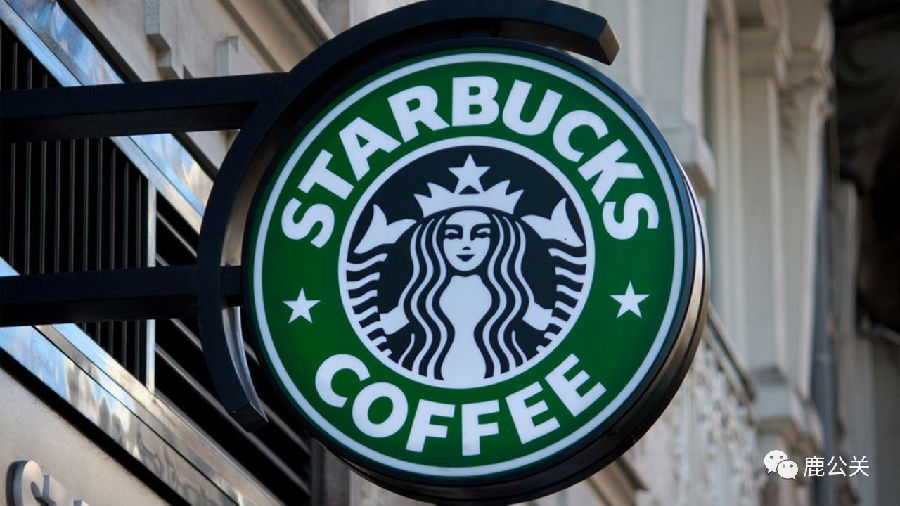
Starbucks went public on NASDAQ 21 years later, and has maintained annual sales growth of 20% and profit growth of 30% since then.
Perhaps I don't quite understand the wealth significance of these figures, probably saying that founder Howard Schultz made Wall Street a very profitable and respected bucket of gold.
Because this white and green coffee logo has been opened all over the world and has become one of the most famous and respected brands in the world.
Starbucks 'Brand Defense
From capital, store operation, talent management aspects are a unique success story, who does not know Starbucks?
However, Starbucks brings this cup of coffee to the world, the most worthy of in-depth analysis is his brand road.
I. Starbucks Brand Infrastructure_Coffee Score, Talent Win
Brands bring added value and scale, which leads to excess profits, and to pursue rapid brand growth, you must lay down an infrastructure that is larger than the "big empire" you envision.
In football, we often say that "offense scores, defense wins", in the brand, the score is generally the product, and the final win in the market or talent, so the founder of every successful enterprise is a person with good intuition for good talent.
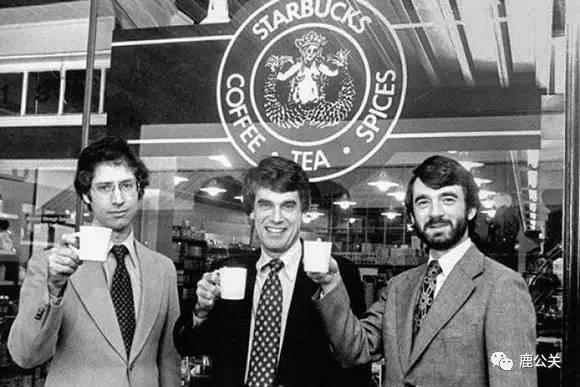
I know very little about coffee, I like Starbucks just like the aroma of coffee in the room, that is, the taste of deep roast coffee with steamed milk, this cup of Italian espresso from Seattle has strict standards in the selection and production of coffee beans, which I will not write about, because Starbucks will always tell their best coffee beans and deep roast for decades.
I want to write about the little-known crisis PR events that have repeatedly caused Starbucks 'stock price to plummet.
2. Guatemala workers sue coffee farmers for only 2 cents
Guatemala labor organizations broke into Starbucks stores and handed out leaflets accusing coffee growers of earning only 2 cents a pound while Starbucks sold them for $9 a pound.
The ILO's formulation of the problem sounds like Starbucks is hiring these coffee growers and eating up huge profits. Without a brand crisis response, Starbucks today is no longer an image of style and social responsibility, but every sip of coffee drunk is the hard-earned money of African coffee farmers.
In fact, such crises are still attacking the social responsibility of famous brands, not quality problems. Starbucks just needs to explain its global sourcing system--it doesn't hire coffee farmers directly.
From the point of view of economists:
If coffee farmers had jobs that paid 3 cents, I believe they wouldn't stay in 2 cent jobs. If Starbucks didn't have demand for coffee beans, wouldn't that 2 cent job cease to exist?
At the same time, Starbucks 'global charity program can also be inclined to assist the world's four famous coffee producing countries-Indonesia, Guatemala, Kenya and Ethiopia.
All founders should understand one truth: when doing charity, enterprises should never take the personal preferences of founders as their purpose, but pay attention to the industry negatives that still exist in the upstream and downstream of the enterprise.
Third, the negative side of attacking big brands usually revolves around social responsibility
Before Starbucks became famous, the quality crisis caused by selling a cup of coffee was actually a small probability event. Even later, Starbucks 'baking factory adopted centralized distribution (no longer the former temporary store but the baking factory) to avoid the problem of product quality through vacuum packaging and other technical means. Buying and selling a single category of ready-to-eat (lightly processed) products, quality safety is not the most troubled brand crisis source. The main sources of crisis, as in the case of ILO in Guatemala, almost always point to the social responsibility of big brands.
IV. Driving up local real estate rental prices
For example, Starbucks has been repeatedly accused by local media and communities of "driving up local real estate rental prices" when it spreads out in various states in the United States. Real estate rental prices around Starbucks stores will rise. Howard Schultz once invited a real estate broker with a very good real estate background to start a beautiful campaign for global location. In my opinion, this is probably an attack that one or two economists can fight off with the "principle of supply and demand", Starbucks can also follow up on its victory and make a big fuss about its excellent location vision.
5. How many whales did the sponsor raise
Starbucks in Vancouver has been sprayed with paint by animal rights groups because it sponsors an aquarium that houses several whales.
VI. Cooperation required to stop Pepsi
Consumer demands put pressure on partner Pepsi to even stop working on the Frappuccino line because Pepsi does business in Myanmar, where human rights are terrible.
These troubles may seem "varied," but they caught Starbucks off guard when they happened, and the ubiquitous competitors and media scrutiny caused the local market to suffer.
Since then, Starbucks has hired local PR firms to help understand the traditional background and potential risks of local cities when entering each market. Some cities really care about certain animals and focus on certain topics.
VII. Environmental protection problems of double-layer paper cups
The controversy over eco-friendly paper cups has plagued Starbucks. To make hot coffee easy to carry, Starbucks has always adopted a double-decker paper cup design. After a lot of trouble, I still haven't found a reasonable solution and replacement materials, so I simply launched the advocacy of "bring your own cup" and reduced some coffee costs. Also improved the double-layer paper cup, changed to the outer layer plus a paper cover, saving three-quarters of the waste.
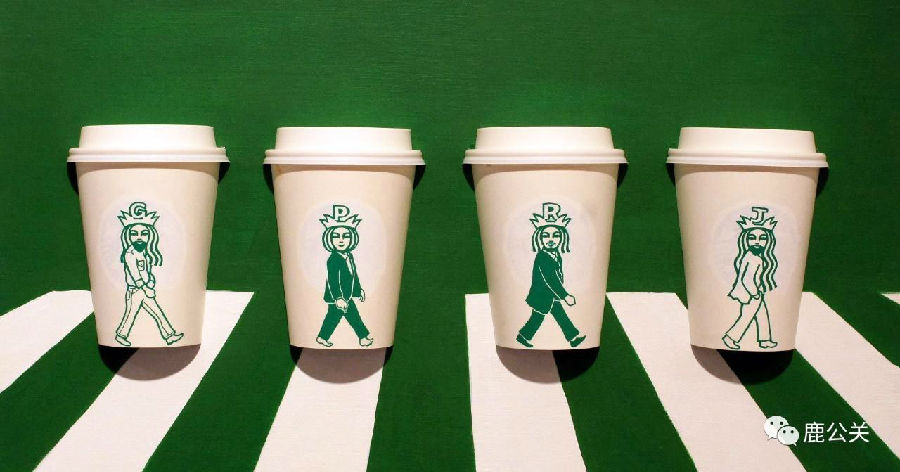
Brand Audit's "Third Eye" Is About Survival
Brand intelligence is related to whether products come from market demand and serve market demand, problems in operation management, talent cohesion and so on.
Corporate PR is required to have an extraordinary ability to describe the industry and the company (vision/values), relationships with partners, and relationships with communities/media/shareholders. Dealing with the negatives of existing markets at any time and place, routine market research, cultural internal audit work and brand external audit are crucial.
As important as financial auditing is, brand auditing is used to capture external, factual, objective, macro, and perhaps negative, hard-to-swallow information that may be relevant to the survival of tomorrow's business.
Financial audit has been quite popular under the requirements of laws and regulations, and it is the standard configuration of enterprises, while brand audit is the beginning of truly establishing differentiated competition.
The next chapter is "Market Intelligence that repeatedly makes Starbucks 'stock price soar"
There are too many possible missteps along the way from green coffee beans in the soil to espresso dripping into a Starbucks cup.
I. Brand is the exclusive relationship between people
The brand's high degree of self-discipline allows a coffee bean to complete a decent transformation.
Brand founders are somewhat crazy temperament, believe in dreams, chase feelings, not so much that they make products, but rather that they maintain a people-to-people exclusive relationship.
Ren Zhengfei and Dong Mingzhu, aren't they crazy?
Without obsession, that is the capitalist, holding money to hunt down the next crazy entrepreneur.
I call this madness professional literary temperament. Every literary youth who has read business is an excellent seed for creating brands. When he meets, he should throw money as early as possible.
Starbucks 'founding team, who are lovers of literature, movies, music, and food, initially wanted to make "Seattle's Best Coffee."
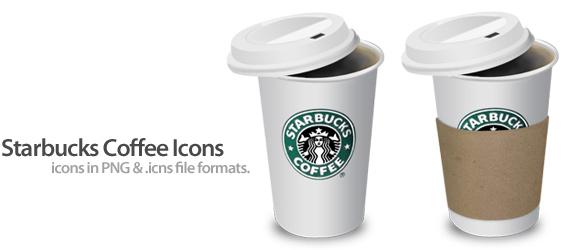
Second, the core of brand is relationship, which comes from market intelligence system.
Too many people are trapped in the misunderstanding that "the core of the brand is the product" and miss the opportunity for enterprise development.
What is the product's place in brand building?
Simply put, the brand is the seller's continuous launch of the popular event, the core is to establish a relationship with consumers, with persistent efforts to promote this relationship to the evolution of "exclusive relationship", and the product is to maintain, promote, please consumers The most powerful point of contact.
What your product looks like should not be the boss's subjective imagination, nor should it be the company's technology field, those who think that the core of the brand is the product, most of them fall into a subjective research and development error.
Are digital cameras technically losing out to cell phone cameras?
No, consumer demand has changed.
Those enterprises that regard the relationship with consumers as the core of the brand have discovered the way to please consumers early_let photos change anytime, anywhere, at will, so the initial low-pixel cameras catch up with technology, digital cameras withdraw from the historical stage, so it is not that technology is not important, but that technology should not blindly follow.
How to find ways to please consumers and keep up with their relationships requires companies to build market intelligence systems like octopus.
"How do consumers view our existing products?"
"How do consumers view our alternative products and direct competitors?"
"What do competitors, including us, cater to that consumer need that might completely capture the wavering target group?"
These intelligence systems are contained in the positive, negative, neutral messages and playful emoticons sent by hundreds of millions of account systems in the mobile Internet era.
What you may not know is that Starbucks breakfast sandwiches have been removed from Starbucks territory twice by founder Howard Schultz, who severely criticized "this is a classic case of Starbucks deviating from its core business, and the burnt cheese flavor overshadows Starbucks espresso". In the game of sandwich two in and two out, it was finally retained. This is thanks to the intelligence PRs get from consumers and the Internet space, and of course, the taste problem has finally improved.
"Starbucks slow service speed" criticized by consumers, when PR intelligence system launched an investigation into what is slowing down the barista's service speed? The criticism was directed at Microsoft DOS, which is still in use (it's hard to imagine that they were still in use in 2009), and Starbucks 'service speed problem has been greatly improved after a thorough technology upgrade.
Do you expect Howard Schultz, who owns 15000 Starbucks and has a market value of 20 billion yuan, and his core team to actively realize this problem in front of the floor-to-ceiling window of the office?
Their competent PR team doesn't dream of that.
What the bosses came up with in front of the floor-to-ceiling windows was the newly introduced Italian summer drink, sherbet, as well as carbonated coffee and iced coffee.
PR people with global intelligence, tell the bosses "sorry, these new products are not popular around the world", out of cost considerations, they have been cut down or even hidden. VIA instant (non-brewed coffee), however, won the surprise.
The reason is simple: PRs have noticed the fast-food coffee market that McDonald's covet.
McDonald's billboards are erected not far from Starbucks Coffee Center in Seattle, and they say--
"$4 coffee is an idiot!"
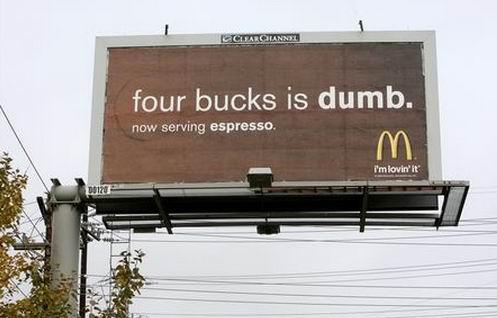
Advertising dependence is an entrepreneur's daydream.
The founders of Dell and Starbucks ride three hours a day along the coast of Kona, a conversation between a world-famous computer and a world-famous cup of coffee.
They don't like pure advertising, which doesn't lead to consistent results and even allows the team to escape the new reality that consumers don't like you.
In China, the factors that pry consumers 'wallets can be summarized as follows:
Cities after Tier 3 focus on price (can your ad spend bring prices down?)
Tier 2 and quasi-tier 1 cities focus on service (can your advertising spend improve service?)
Line 1 focuses on the environment, health and producer ethics, such as tax liability vs. philanthropy; shareholder interest vs. social conscience; profits vs. humanity; regional identity vs. global positioning (does your ad spending make you look like an ethical business?)
If your advertisement can achieve any of the above effects, put it into the corresponding city, if it can, heavily hit the whole country, if not, it should not give up strong self-appreciation feelings, and face the market reality.
Starbucks, the world's largest retailer by daily traffic, tells you that "no single product, manager, or innovation can establish the value of a brand in one fell swoop, but destruction can be done." If scaling up is seen as a success, it is bound to fail."
It requires global awareness and system building, and is a determination to establish emotional ties with customers.
Important Notice :
前街咖啡 FrontStreet Coffee has moved to new addredd:
FrontStreet Coffee Address: 315,Donghua East Road,GuangZhou
Tel:020 38364473
- Prev

Coffee shop design appreciation: Kanagawa small Cafe in Japan
This small cafe is located on the street of a quiet residential area in Kanagawa's Odahara city. Designed and built by Hiroyuki Shinozaki. The upper part of the building is a collection of wooden volumes of different sizes, and the interior of them is made into an empty state, as if suspended above the building. Below is the use of glass partition to create different spaces, although they are separated, but in the line of sight
- Next

She moved the flower class into the cafe.
Li Qian feels very satisfied to be with flowers every day. Every time I see flowers, I always think of the Jindalai flowers in my hometown when I was a child. If I can deal with flowers in my future life, my life will be the most wonderful. In 1991, Li Qian, the owner of the florist and a major employee of the florist, said. The college student who was born in 1991 and graduated from Chinese as a foreign language said bluntly:
Related
- What documents do you need to go through to open a coffee shop? coffee shop coffee shop certificate processing process
- How to purchase Coffee beans in small Cafe how to choose a suitable supplier for domestic Coffee supply Company
- How to drink Starbucks Fragrance White Coffee? how to make Australian White Coffee? what Italian coffee beans are recommended?
- The Story of Flora Coffee: the name of Flora Coffee Bean and the implication of the Flowers on Florna Coffee
- How much does a cup of coffee cost? How much is the profit of a cup of coffee? What is the profit of the coffee shop in a year?
- Yunnan small Coffee, known as "fragrant Coffee", introduces the characteristics of Alpine Arabica Coffee producing areas in Yunnan, China
- 2023 latest Starbucks full menu price list how much is a cup of Starbucks coffee what is better to drink the most popular hot and cold drinks recommended
- Starbucks different kinds of Coffee Price list Starbucks menu 2023 Top Ten Best drinks in Starbucks
- Starbucks Spring praise Comprehensive matching Coffee Bean theme Story Packaging implication and taste description
- The cost of a cup of coffee latte American coffee cost price and selling price

